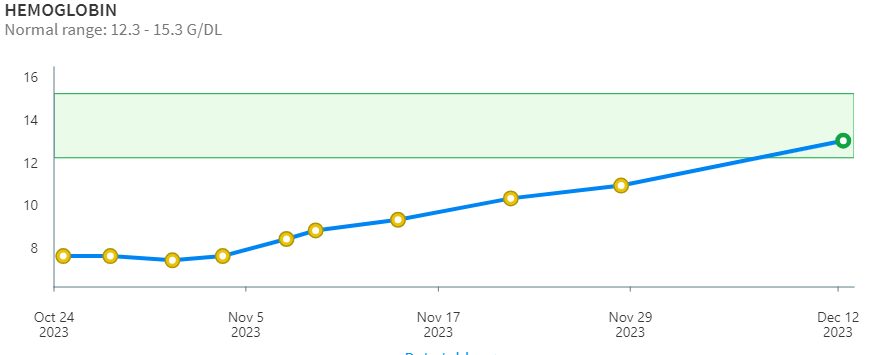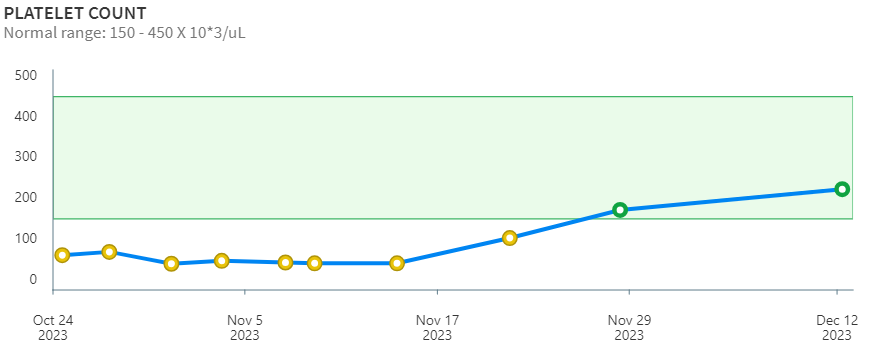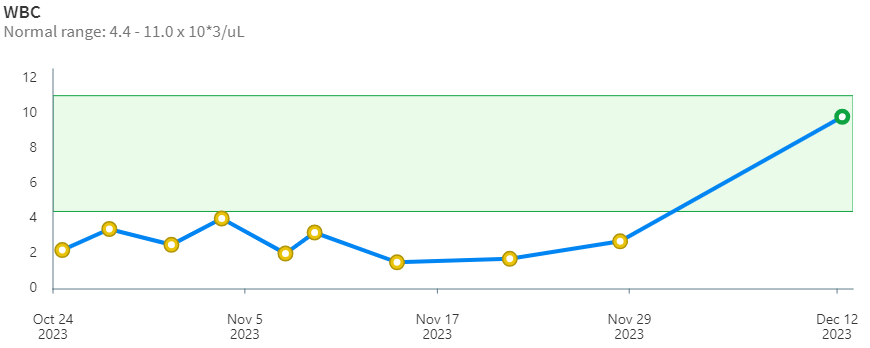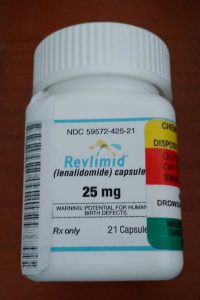I am on elotuzumab, dexamethasone, and pomalidomide now. I am in my second cycle. It’s been working great. My CBC is better than it’s been in years. Here are my most recent results in graph form.



Beth Morgan Multiple Myeloma Treatment Blog
My life as a myeloma patient for almost two decades
Next month, I’ll start the CAR T-Cell therapy process with CARVYKTI®. I’ll start by having a vascath inserted. We used to just call these “Hickmans,” which is a brand name, no matter who made them. This is what a central venous catheter looks like: https://myeloma.blog/this-is-a-neostar-triple-lumen-catheter/ and this is what a Hickman looks like: https://myeloma.blog/hickman-catheter/.
Anyway, my first encounter will be in January. I’ll have the catheter inserted and then will have leukapheresis. After that, my T cells will be shipped off to a lab to be engineered to fight myeloma. Next, the T cells will be multiplied. After that (a procedure that can take two to several weeks), the T cells will be shipped back to the hospital. The next thing I’ll have to do is undergo three days of chemo: fludarabine and cyclophosphamide.
The CARVYKTI® website describes the process best.
I’ll update as often as I can.
In October, 2023, treatment with cyclophosphamide, carfilzomib, and dexamethasone stopped working. My PET scan lit up like a Christmas tree. My lab results suddenly looked awful. I needed a unit of blood.

After starting another treatment, I had a quick response, and lab results returned to nearly normal levels. Normal for me.
This is just a quick update. I’m still on Darzalex, but am also taking 2 mg of Pomalyst (pom) 21 days a month. I’m not taking dex at the moment. I just get 20 mg of dex with each dara infusion. We’ll see how that goes.
For the last 3 or 4 months, I’ve been getting dara via rapid infusion. That cuts down on a lot of chair time. It feels like I may be having some more pronounced side effects from the rapid infusion in the form of fatigue and a bit of just feeling yucky. I asked my doctor if he’s heard others say they feel a little worse after the rapid infusion, and he said that seems to be the case with some people.
Anyway, I am still alive and am stable at this point.
dara = daratumumab
pom = pomalidomide
I haven’t posted any updates lately. The reason is, after having had MM for so long, I just don’t think about it very much. It’s not like it was in the beginning. I used to wake up every day, and that was the first thing I’d think about. That was 2003. It’s just a part of my life now. I’ve been very fortunate to have had few problems.
 In January I started on Darzalex, Revlimid and dex. I’d taken Revlimid before, in 2006. You can read all of my previous posts about Revlimid here: https://myeloma.blog/?s=Revlimid. I have not tolerated it well, so I stopped taking it at the end of January. In fact, I felt so miserable that when it came to taking that last pill in the bottle, I couldn’t make myself do it. Revlimid causes me to have some really awful GI issues. I think I can understand what people must go through when they have IBS or similar afflictions. Revlimid causes me to have GI cramps, diarrhea, constipation, and some nausea. That was at a 25 mg per day dose. I may be trying a 15 mg per day dose soon.
In January I started on Darzalex, Revlimid and dex. I’d taken Revlimid before, in 2006. You can read all of my previous posts about Revlimid here: https://myeloma.blog/?s=Revlimid. I have not tolerated it well, so I stopped taking it at the end of January. In fact, I felt so miserable that when it came to taking that last pill in the bottle, I couldn’t make myself do it. Revlimid causes me to have some really awful GI issues. I think I can understand what people must go through when they have IBS or similar afflictions. Revlimid causes me to have GI cramps, diarrhea, constipation, and some nausea. That was at a 25 mg per day dose. I may be trying a 15 mg per day dose soon.
The reason I may be trying a lower dose is that Darzalex as a single agent (with 20 mg of dex) has not held my MM back. Dara (Darzalex or daratumumab), Rev & dex did a great job up front, though. But since I stopped Rev, the numbers have started climbing.
My doctor wants to try to get me on Pomalyst. In January, we were told that my insurance would not pay for Pom at the same time I’m getting dara. It’s considered an off label use of the combination. He says he thinks he can get it approved this time. If it doesn’t happen, I’ll use 15 mg of Rev.
Jan Bieschke of Washington University in St. Louis studies how proteins fold and shape themselves, and how these processes can contribute to a variety of diseases. He says the compound epigallocatechine-3-gallate (EGCG), a polyphenol found in green tea leaves, may be of particular benefit to patients struggling with multiple myeloma and amyloidosis.
These patients are susceptible to a frequently fatal condition called light chain amyloidosis, in which parts of the body’s own antibodies become misshapen and can accumulate in various organs, including the heart and kidneys.
“The idea here is twofold: We wanted to better understand how light chain amyloidosis works, and how the green tea compound affects this specific protein,” says Bieschke, assistant professor of biomedical engineering at the School of Engineering & Applied Science.
Bieschke’s team first isolated individual light chains from nine patients with bone marrow disorders that caused multiple myeloma or amyloidosis, then ran lab experiments to determine how the green tea compound affected the light chain protein.
“We all want this compound to work in a patient.”
Bieschke previously examined EGCG’s effect in both Parkinson’s and Alzheimer’s disease, and found it prevented dangerous buildups of protein present in both diseases. His team had a similar conclusion in this study: In the lab using samples from bone marrow patients, the EGCG transformed light chain amyloid, preventing the misshapen form from replicating and accumulating dangerously.
“In the presence of green tea, the chains have a different internal structure,” Bieschke says. “The ECGC pulled the light chain into a different type of aggregate that wasn’t toxic and didn’t form fibril structures,” as happens to organs affected by amyloidosis.
While Bieschke is gaining a greater understanding at the intracellular processes involved, his partners at the University of Heidelberg are working in tandem with him, running clinical trials.
“My group is looking at the mechanism of the protein in a test tube; we are studying how it works on a foundational level. At the same time, clinical trials at the Amyloidosis Center in Heidelberg, with Alzheimer’s in Berlin and with Parkinson’s in China examine the process in people. We all want this compound to work in a patient.”
The research appears in the Journal of Biological Chemistry.
During the time I was in treatment, I coordinated my doctor visits and chemo with another myeloma patient who lives about 25 miles from here. We traveled to Chapel Hill appointments together and, when we were told the only treatment left to us was a stem cell transplant, we had ours together through The Duke Adult Blood and Marrow Transplant (ABMT) Program in Durham, NC. We even had apartments next door to one another!
One of our doctors started calling us the “myeloma twins.”
I’m really glad to have just gotten the news that Joyce is moving to Pinehurst, which borders on Southern Pines (where I live)! She’ll only be a few miles away, so we’ll get to see each other more often.
Yay!
I got these results last week. Pretty much the only difference between these results and the last ones is that the IgA is about 200 mg/dL higher. Last time, it was 663. The m-spikes are the same. This time, the kappa/lambda free light chain ratio is just inside the normal range. IgM and IgG are suppressed, and at about the same levels they were in October. Why the increase in IgA? My doctor suggested that it may simply be a normal immune response to something.